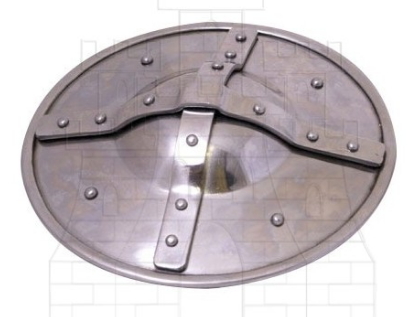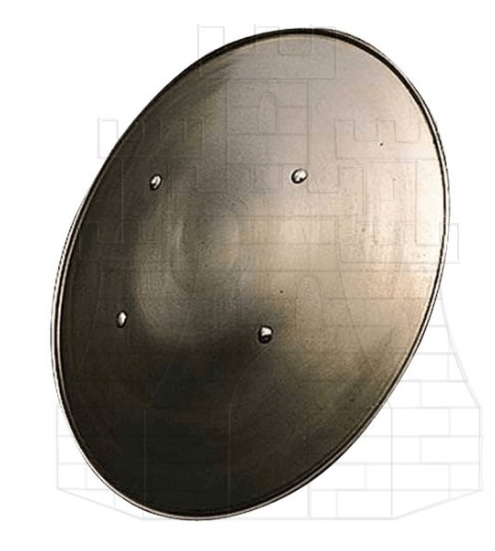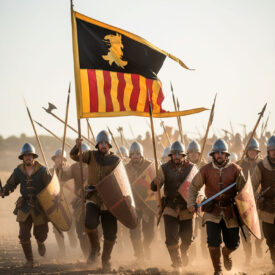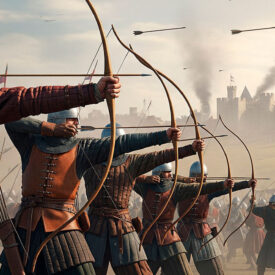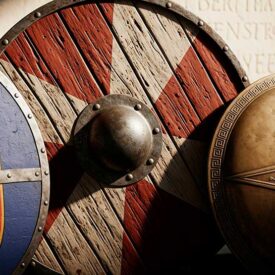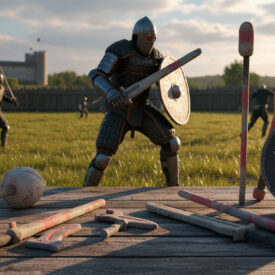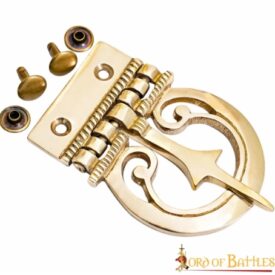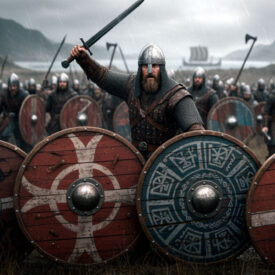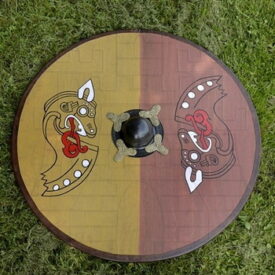Legend has it: the first shield that stopped a rain of arrows
Legend has it that, at the twilight of a distant battle, a warrior raised a piece of cured wood and, with that gesture, changed the course of the fight. That simple refuge against steel and stone was the precedent of what centuries later would become the functional medieval shield: a tool that combines defense, identity, and technique. In these lines, you will discover how these pieces were forged, what to look for in a functional replica, and how to maintain it so that it survives both history and real use.
Shields throughout time
Following the pulse of history, this chronology condenses the milestones that defined the evolution of the shield, from warrior myths to verifiable tactical implementations.
- Antiquity (before the 5th century): Round and rectangular shields dominate Mediterranean fields; simple materials and early joining techniques.
- 5th–11th Century: Cultural diversification: round Viking shields, late Roman scuta, and early regional variations.
- 10th–12th Century: Appearance of the almond-shaped shield in the West, associated with the Normans; optimized for cavalry.
- 13th–16th Century: Transition to triangular and heraldic shields; designs combining protection with personal identification proliferate.
- 16th Century: The shield as a ceremonial object—rotellas with reliefs and luxury fabrics—while on some fronts the shield begins to lose its primary function.
- Modern Era (20th–21st Century): Revival of functional replicas: a mix between historical authenticity and contemporary safety criteria, with shields designed for recreation, LARP, and historical fencing.
Why a functional shield is not just an adornment
A functional shield is the union between tradition and utility. It does not just seek to “look” medieval: it is designed to withstand repeated blows, protect in real maneuvers, and allow historical combat techniques. Understanding this difference will allow you to choose judiciously and extend the useful life of the piece.
Elements that define a functional shield
A modern shield for recreation usually contains the same practical elements as its predecessors, but adjusted to safety requirements:
- Umbo: The central metal protector, used both for defense and to strike blows with the shield itself. It protects the hand and distributes impacts.
- Enarmes: The internal straps that allow gripping the shield and maneuvering it with precision.
- Tiracol: Transport system that facilitates carrying the shield on the go.
- Contera: Lower reinforcement that allows the shield to be planted or rested; very present in pointed shields.
- Radial reinforcements: Strips or metal bands that increase the rigidity of the piece and prevent it from opening after continuous impacts.
Materials and construction: tradition and technique
The soul of a functional shield lies in its materials and how they are combined. Tradition provides proven materials; modern technique provides assemblies that withstand repeated use.
Woods: choices that matter
Classic woods include basswood, oak, and ash. Basswood is light and malleable, ideal for round shields that require maneuverability. Oak provides robustness for pieces that must withstand continuous impacts. In historical replicas, laminated woods are often used to prevent deformation, maintaining a functional thickness close to 1 cm in multilayer laminated sheets.
Coatings and reinforcements
An ancestral technique consists of applying layers of canvas or linen impregnated with glue to increase flexibility and resistance, similar to a primitive “fiberglass.” Raw leather on the edges protects against moisture and abrasion. Metal fittings in tension areas prevent breakage and prolong useful life.
Metal elements: umbo, contera, and studs
The umbo protects and serves as an offensive point; the contera reinforces the lower edge. Studs and rivets armored critical areas and added an aesthetic plus. In modern practice, these elements are sized for safety: well-secured rivets and umbos that do not have sharp edges.
Historical typologies and their functional version
Knowing the typology guides you in choosing the shield according to the era you want to represent and the intended use.
- Viking shield: Round, with a prominent umbo. Ideal for historical fencing maneuvers that require agility.
- Norman shield (tear-shaped): Long and with a lower point, designed for cavalry and for resting on the ground in formations.
- Triangular heraldic shield: Smaller and more decorated; frequent in infantry and heraldic representations.
- Buckler: Small and maneuverable, perfect for dueling and training in confined spaces.
- Roman scutum and tower shields: Large, designed to cover and protect rows of soldiers.
How to choose according to your discipline: LARP, recreation, or historical fencing
Each discipline demands different priorities. Consider these factors before deciding:
- Safety: For historical fencing, the solidity of the grip and the integrity of the umbo are paramount.
- Visual authenticity: In re-enactment, the pattern, shape, and materials must match the represented era.
- Ergonomics: In LARP, comfort and lightness may be more relevant than absolute fidelity in each component.
Quick checklist before using a shield in simulated combat
- Check that the enarmes and tiracol are firm and without excessive wear.
- Inspect the umbo and rivets for looseness.
- Verify that the coating does not show detachment or soft spots.
- Confirm that the weight and size allow maneuvering for more than 10 minutes without excessive fatigue.
Models, variants and where each type fits
The world of functional shields is broad. Here’s how models fit into different contexts of use.
Comparison: materials and applications
| Material | Advantages | Disadvantages | Recommended Use |
|---|---|---|---|
| Basswood (solid wood) | Light, easy to work | Less resistant than oak | Round shields and bucklers |
| Laminated Oak | High resistance, stable | Heavier | Shields for intense combat and formations |
| Linen/canvas + glue | Greater flexibility and durability | Requires maintenance | Functional historical reproductions |
| Leather on edges | Protects against moisture and impacts | May wear out over time | All typologies |
| Metal fittings | Reinforces critical areas | May add weight | High-wear shields |
Care and maintenance that extend the life of the shield
The durability of a functional shield depends as much on its construction as on subsequent care. Applying historical practices with modern tools achieves excellent results.
Maintenance routine
- After use: Dry and clean; check for cracks or loose rivets.
- Preventive treatment: Light oiling of the wood or punctual application of historical varnish if group regulations permit.
- Annual inspection: Re-adjust enarmes, reinforce studs, and inspect leather on edges.
- Repairs: For significant cracks, use glues and braces or go to a specialized craftsman.
Historical use techniques that are still relevant
Ancient combat manuals and the experience of reenactors show that many traditional techniques remain valid. Among them:
- Blocking: Using the shield to intercept the trajectory of the enemy’s weapon, redirecting the force.
- Pushing: Using the shield in combination with the spear or sword to create space or break lines.
- Dynamic protection: Continuous movement of the shield to cover exposed areas according to the adversary’s distance.
Customization and aesthetics without sacrificing safety
Heraldic decoration and symbolic elements are part of the shield’s appeal. However, it is possible to combine aesthetics and safety:
- Painting on sealed layers: Painting on a well-adhered linen or canvas surface prevents flaking during use.
- Eco-fixed insignia: Use non-cutting studs and internal rivets to secure elements without creating dangerous edges.
- Internal padding: Add a soft layer in the grip area to cushion impacts without modifying the external appearance.
Frequently asked historical questions answered in a few lines
Why is it carried on the left arm? To free the right hand for attack. It is the classic arrangement from antiquity to medieval cavalry.
What is the umbo and why is it crucial? It is the central metal piece that protects the hand and allows the shield to be used as a pushing weapon.
Final recommendations for the demanding reenactor
Choosing a functional shield means making a commitment: preserving authenticity, ensuring safety, and learning its usage technique. Opt for proven materials and construction, adapt the size to your build, and follow a rigorous maintenance plan. Thus, every beat, every clash, and every tournament will be an opportunity to learn and keep tradition alive.
The shield is not just wood and metal: it is an extension of history and of whoever carries it. Treat it with respect and it will offer you protection and narrative in every encounter.
VIEW FUNCTIONAL SHIELDS | VIEW MORE MEDIEVAL SHIELDS | VIEW SHIELDS OF ALL ERAS

